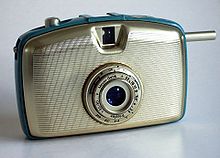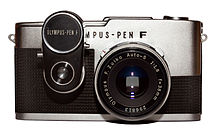Half format camera
A half-format camera is a camera that usually uses conventional 35 mm film ( i.e. 35 mm film ), but does not expose the images in the usual 24 × 36 mm format , but instead uses the original silent film format 18 × 24 mm. This is therefore also referred to as a half format .
The number of pictures doubles compared to the small picture format to 24 (instead of 12 pictures), 48 (instead of 24 pictures) or 72 (instead of 36 pictures). With a special black and white thin film, up to 114 images can be obtained in a camera of regular size.
From Yashica the half format was incorrectly like advertised as a double format because of the number of images. The term double format actually stands for the regular 24 × 36 mm format in contrast to and comparison with the 18 × 24 mm half format.
Models
In the history of photo technology , experiments with half-formats took place several times and early on.
The publication of the Olympus Pen F (1963) led to a boom in the 1960s, which was followed by a whole series of models (Pen FT, Pen FV, etc.). Other manufacturers such as Minolta , Canon and Konica then developed their own half-format models.
With the various models of the pen series ( viewfinder cameras and reflex cameras ), Olympus is the manufacturer with the longest production time (approx. 1960–1983), despite the discontinued half-format series. In addition to the cameras of the Olympus Pen F series - which are considered to be the best known - there are also SLR cameras with interchangeable lenses from other manufacturers. However, these are usually conversions of regular cameras for special purposes or small series of regular SLR cameras in half format. The Yashica SLR series, in turn, each have a built-in zoom lens .
Also worth mentioning is the Minolta Electro-Zoom X (also Minolta 16 Electro-Zoom-X ), which was presented in 1968 as a design study for a single lens reflex camera, but was never commercially produced. She used an even smaller half format of 12 × 18 mm on 16 mm film , which was to be packaged in Minolta 16 mm cassettes (10 × 14 mm).
Conversions and special constructions exist for investigative authorities and the police. In addition, large-capacity magazines were sometimes used here.
A total of 143 different half-format cameras are known, mainly from Japanese and Soviet manufacturers. Some more popular models are:
-
Agfa
- Parat or Optima Parat (1963)
- Paramat (1963)
-
Welta later VEB Pentacon work with rapid film cartridges
- Penti I (1959)
- Penti II (1961-1977)
-
BelOMO
- Chaika (1965-1967)
- Chaika-2 (1967–1972), with interchangeable lens
- Chaika-2M (1972–1974)
- Chaika-3 (1971–1973), with selenium light meter and without "B" shutter time.
-
KMZ
- Zenit MT-1 Surprise (1979-1990)
-
Lomo
- Conversion of Soviet Lomo cameras to half-format cameras.
- Lomo constructor UFK2 (kit)
- Agat, Micron, partly different versions, also in 24 × 36
- Diana Mini
-
Konica
- Mirror reflex Auto-Reflex or Autorex (1965), switchable between normal 35mm and half format even during the film
-
Minolta
- Repo (1963) and Repo-S (1964)
- AA-35 and recorder
-
Canon
- Demi, different models
- Dial 35 (1963-1971) and varieties
-
Olympus
- Viewfinder camera Pen, Pen D and Pen EE, various and related models
- SLR Pen F, Pen FT and related models. Compact design, Porro prism and rotor lock.
-
Yashica
- Half 17 Rapid (1965), viewfinder camera, and similar models
- Samurai (1988), various models. Fully automatic single lens reflex cameras with autofocus and fixed zoom. Built-in flash, data exposure back wall, in video camera design, but no interchangeable lenses. The last models were produced until 1994.


